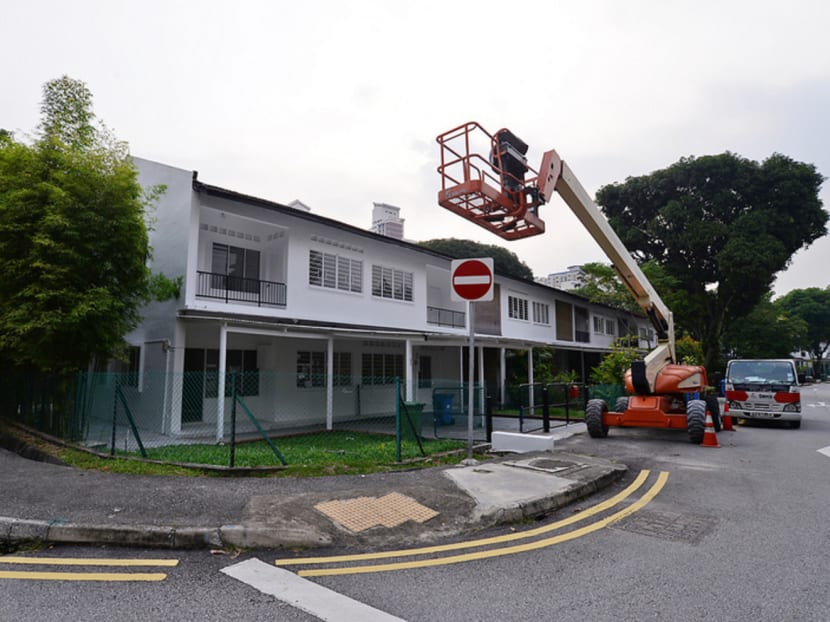New roof awnings at Chip Bee Gardens to be fixed
SINGAPORE — Nearly a year since asbestos, a hazardous material, was discovered in roof awnings of terrace houses at Chip Bee Gardens, about two-fifths of replacement works have been completed, said the Singapore Land Authority (SLA).
SINGAPORE — Nearly a year since asbestos, a hazardous material, was discovered in roof awnings of terrace houses at Chip Bee Gardens, about two-fifths of replacement works have been completed, said the Singapore Land Authority (SLA).
But those who have gotten the new metal awnings complained that they retain heat and also generate more noise when it rains, prompting the SLA to slather on a special paint to address these issues.
Responding to TODAY’s queries, an SLA spokesman said that it completed inspection of all the 323 terrace houses with corrugated roof awnings in the area last July.
Of this, the awnings of 126 houses, which had substantial cracks, were replaced by November last year.
Meanwhile, the awnings of 167 houses — found to have slight cracks — have been painted over to seal in the asbestos fibres as a temporary measure.
The SLA said it will replace the awnings of these houses as well as those in 30 other houses which have been assessed to be in good condition.
“SLA is currently planning the next phase of works, which is to progressively replace the remaining asbestos awnings at the estate,” said the spokesperson who declined to reveal the cost of the replacement works.
The matter came to light after the front awning of a vacant unit along Jalan Puteh Jerneh was reported on April 26 last year to be damaged. After checks, it was established that there was asbestos in the corrugated roof and the roof was removed three days later.
Asbestos is a hazardous material that could cause lung cancer and other illnesses if its fibres are inhaled over a prolonged period.
Structures containing asbestos pose no risk to humans if they are intact. However, when there is damage or disturbance — such as sawing and cutting — fibres may be released into the air and inhaled.
As the SLA had previously said, rental waiver was provided to tenants who had to move out temporarily due to the replacement works, which were carried out by an approved asbestos removal contractor certified by the Ministry of Manpower (MOM).
Residents TODAY spoke to last week said the authorities have responded swiftly to the situation and that replacement works were also carried out on schedule.
Mr Robert Hensby, who lives at one of the houses along Jalan Puteh Jerneh with his wife, said that the authorities did the “right thing” by inspecting every house.
Replacement works for his awning — carried out last August over four days — was also completed on time, he added.
The 42-year-old, who pays S$3,100 in rent every month, said that there was also a deduction in his rental fees for the following month, although he declined to reveal the exact amount.
TODAY understands that there were also cases of residents terminating their tenancy prematurely without serving the notice period because of concerns over the asbestos.
When asked about this, the SLA only said that it has given approval “to a small number of them” but this was done on a case-by-case basis.
Ms Karen Taylor, a resident at one of the houses along Jalan Hitam Manis, said that “there was a lot of hysteria” when news about the asbestos broke. While her awning was encapsulated, she said that some neighbours complained that their new awnings capture heat and “make more noise”.
Acknowledging that residents had given feedback on this, SLA said that the awnings were then coated with a multi-layer emulsion paint which “proved to be effective to reduce heat and noise”.
A Caucasian male resident in his mid-30s, who declined to be named and has been living along Jalan Puteh Jerneh with his family for about two years, said that his awning was one of the first to be replaced with the metal version.
But “it was very loud when it rained to the point that it was hard to sleep”, he added. He said that following residents’ discussions with SLA, a device was installed at the estate for a week to measure the decibel reading and “then they agreed that a solution was needed”.
“Now, it’s very quiet when it rains. If I still had just the metal roofing without the noise reduction, I’d be quite unhappy but they got mine done so I can’t complain,” said the resident.
In Singapore, asbestos was banned from use in building materials in 1989.
But before that, it was commonly used — such as for corrugated roofs, ceiling boards, floor tiling and partition walls — because the natural, fibrous mineral has high tensile strength and good heat and fire resistance.
The Chip Bee Gardens houses were built in the 1960s and are now managed by SLA, which leases them out.
A similar incident related to state-owned properties occurred in 2012, when four vacant units at Hume Heights were found to have materials containing asbestos. They have since been replaced.
On average, there are about 200 cases of asbestos removal each year, according to MOM figures.







